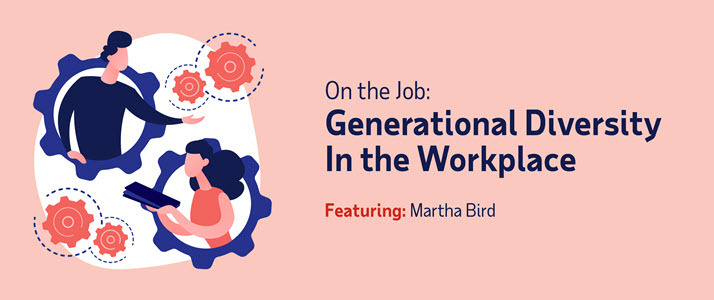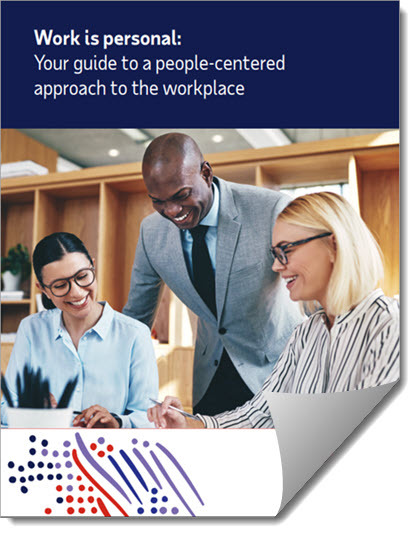How to Manage Generational Differences in the Workplace

In this "On the Job" segment, Martha Bird, chief business anthropologist, ADP, chats with Cheddar News about managing and celebrating generational diversity at work.
Generational differences in the workplace are plentiful, ranging from differences in beliefs to differences in working styles and more. Additionally, today's workplace is incredibly diverse generationally, comprising up to five generations working together: Generation Z, Millennials, Generation X, Baby Boomers and the Silent Generation.
How can today's organizations manage multi-generational workforces? How do you lead different generations in the workplace, why is it important to understand generational differences and what are the benefits of generational diversity?
Above: Speaking with Cheddar News, Martha Bird (MB), chief business anthropologist, ADP, says it boils down to curiosity, co-learning, collaboration and respect.
Q: What are the challenges of adding a new generation to the workplace?
MB: When you bring people together who have diverse life experiences, you're bound to have a culture clash. It doesn't need to be something to fear. Rather, the challenge is thinking about it more in terms of being an opportunity. This is where curiosity and lateral thinking come into play. People leaders set the tone. I would say embrace diversity. Seek deeper understanding of how others think and feel. Ask yourself: What are their frames of reference? What motivates them? What do they think they need from their work environments? For instance, a Gen Zer is likely looking to learn new skills. A Boomer might be more interested in sharing institutional knowledge and domain expertise. But both can benefit from sharing their unique wisdom. Opportunity for growth on all sides; that's a win-win.
I'd caution against generational caricature. Stereotyping tends to block the deeper, more nuanced understandings of meaningful differences and similarities. I've spoken to Millennials who feel their younger Gen Z co-workers seem to want to pass their work on to others, while Gen Zers say they just want to be collaborative. Many have been taught from their earliest education onwards to work together to figure things out, and they've had the tools to do just that. Misunderstandings like these can happen. The bottom line is: Multiple generations working together provides diverse perspectives, complementary experiences and an enhanced company culture.
Q: How can employers make integration of new generations as smooth as possible?
MB: Integration may not actually be the goal. It's not integration. It's, "Let's not fit in. Let's collaborate together." This comes down to a focus on curiosity, co-learning and collaboration. Growth and innovation come from healthy friction. It sets up the opportunity to challenge our assumptions and our beliefs. A lot of times, we get locked into the way we've been raised or the things that we think, and we really forget that other people have those experiences but that they may also be very different. One of the most rewarding outcomes of working on diverse teams is when, during a team meeting, someone says, "Hey, I never thought of it that way before." This is so much more productive than everyone agreeing, which is typically the case when we spend time with people most like ourselves.
We need more debate and creative friction to help move things forward. It's that kind of electric moment that expands our point of view and helps us think differently. Employers might think and encourage this kind of multigenerational co-learning by leading by listening, and what does that actually mean? It means sharing your point of view, and then, pause. Listen to the spoken and unspoken messages. I also think you need to create new spaces for intentional connection, for example, arranging one-on-ones between people from different generations to create new understandings around relevant topics, like what does success look like and feel like individually and as a team? And finally, embrace discomfort. Practice letting go of the comfort of the familiar, and that comes from exposure to people and ideas outside of your norm.
Q: How have changes of the past few years influenced the complexity of hiring and retaining people across generations?
MB: The reality of today's environment has affected people at work across generations. Age was just one variable. Perhaps Gen Z can be credited with leading the way in seeking employers that promote greater flexibility and that connect with their own values. Today, employers need to offer more than a good salary. They need to show a deeper awareness of the needs of people at work and home. They need to create policies that support the different stages of people's lives. And your employees are also your consumers, and, at a time when customization and on-demand have really become expectations for many of us, the opportunity and the ability of enterprises to deliver it in these ways internally also becomes very important. Finally, companies need to value culture in a more focused and actionable way. When they do that, they are more likely to attract and retain the right people to help their organizations thrive.
Q: If you could implement one approach to helping organizations move forward as Gen Z joins the workforce, what would it be?
MB: Focus on people as individuals while creating opportunities for greater connections within the whole team. Invest in refining your onboarding processes to grow with your people and adapt with the variables they face, and ensure it evolves into an ongoing development opportunity to keep people connected and engaged at work. People need to be seen, they need to feel valued and they need to be heard. That's across generations. Organizations that acknowledge and act on this through intentional policy-setting and more people-centered practices will be the ones that people gravitate to. It's all about treating people the way you want to be treated, regardless of what that looks like, so respect will always be the key.
In the post-pandemic world of work, the organizations that prioritize people first will rise to the top. Find out how to make HR more personalized to adapt to today's changing talent landscape. Get our guide: Work is personal
For more on generational differences in the workplace and managing a multi-generational workforce, read How to Build a Diverse Workforce by Engaging Younger Generations and How Reverse Mentoring Can Help Promote Generational Diversity Awareness.




